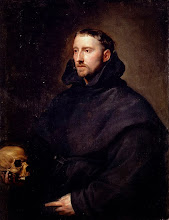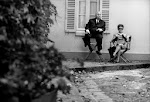Tuesday, July 31, 2012
Monday, July 30, 2012
In Memoriam: Chris Marker (1921-2012)
Born Christian François Bouche-Villeneuve, Marker always jealously preserved his privacy, eshewing interviews and cultivating an air of enigma that crossed over into his work. Even his birthplace is disputed, with Neuilly-sur-Seine and Mongolia both mooted, although he did spend the war years in the French Resistance and the US Army in Europe.
Emerging as a key figure in the Paris Left Bank in the post-war years, he wrote for Cahiers du Cinéma and published novels, poems and essays before turning to documentary and feature filmmaking.
Smart, cerebral and provocative, Marker's films were marked by a genius for experimentation, bold themes and, in the case of pro-Castro treatise ¡Cuba Sí!, a political bent that alienated as well as inspired.
His greatest work, though, was La Jetée ('The Jetty') in 1962. The 27-minute short crammed in enough dystopian nightmarishness to fuel the imagination of filmmakers from Terry Gilliam, who famously remade it as Twelve Monkeys in 1995, to Richard Kelly and Duncan Jones. Set partly in Orly Airport after a nuclear holocaust, it uses photomontage to follow the fate of an unnamed prisoner (Davos Hanich) sent back and forward in time by his interrogators.
Longer but equally innovative, docu-travelogue Sans Soleil (1983) blended fictional and factual strands into a languid essay on memory and history. Its budget was so small that Marker told of capturing the audio track on a cassette recorder. In his later years Marker enthusiastically adopted digital technology, using it for multimedia installations at the MoMa in New York and films like Level 5 (1996) and Immemory (1998).
He will be remembered as a true pioneer of filmmaking in all its guises. Alain Resnais, with whom Marker worked as assistant director on Night And Fog in 1955, described him as "the prototype of the 21st century man".
Longer but equally innovative, docu-travelogue Sans Soleil (1983) blended fictional and factual strands into a languid essay on memory and history. Its budget was so small that Marker told of capturing the audio track on a cassette recorder. In his later years Marker enthusiastically adopted digital technology, using it for multimedia installations at the MoMa in New York and films like Level 5 (1996) and Immemory (1998).
He will be remembered as a true pioneer of filmmaking in all its guises. Alain Resnais, with whom Marker worked as assistant director on Night And Fog in 1955, described him as "the prototype of the 21st century man".
Sunday, July 29, 2012
Saturday, July 28, 2012
Friday, July 27, 2012
Thursday, July 26, 2012
Wednesday, July 25, 2012
Tuesday, July 24, 2012
PARISTEXAS
Denmark-based design agency Scandinavian DesignLab took on the task of creating a branding scheme for Copenhagen-based fashion store PARISTEXAS with a most unusual series of designs that merge bugs with musical instruments.
The clothing retailer esteems itself on its distinct and distinguished outlook on fashion, deeming itself a trendsetter rather than a follower. Thus, the creatives at the branding agency knew that their design tactic had to confront the conventions of beauty and challenge those standards.
Scandinavian DesignLab says, "The assignment involved creating an identity that breaks with the traditional thinking behind identities and by extension supports a sense of unique, international exclusivity and underground style."
By combining the image of creepy crawlers with that of refined classical instruments to form one entity, the agency draws metaphoric lines between two contrasting elements to create a new style to attract attention or perhaps redefine beauty. The agency's designs not only identify their client's trendsetting brand, but reflect the polarity present in the company's name — Paris, the City of Lights, and Texas, the Lone Star State.
Sunday, July 22, 2012
Vampyr (1932)
Vampyr (German: Vampyr – Der Traum des Allan Grey) is a 1932 French-German horror film directed by Danish director Carl Theodor Dreyer.
The film was written by Dreyer and Christen Jul based on elements from J. Sheridan Le Fanu's collection of supernatural stories In a Glass Darkly. Vampyr was funded by Nicolas de Gunzburg who starred in the film under the name of Julian West among a mostly non-professional cast.
Gunzburg plays the role of Allan Grey, a student of the occult who enters the village of Courtempierre, which is under the curse of a vampire.
Vampyr was challenging for Dreyer to make as it was his first sound film and had to be recorded in three languages.
To overcome this, very little dialogue was used in the film and much of the story is told with silent film-styled title cards.
The film was shot entirely on location and to enhance the atmospheric content, Dreyer opted for a washed out, fuzzy appearing photographic technique. The audio editing was done in Berlin where the character's voices, sound effects, and score were added to the film.
Vampyr had a delayed release in Germany and opened to a generally negative reception from audiences and critics. Dreyer edited the film after its German premiere and it opened to more mixed opinions at its French debut. The film was long considered as a low part in Dreyer's career, but modern critical reception to the film has become much more favorable with critics praising the film's disorienting visual effects and atmosphere.
Saturday, July 21, 2012
Wednesday, July 18, 2012
Kurt Pershke RedBall project in UK
This summer, New York artist Kurt Perschke brought his RedBall project to the UK for the first time, installing his massive inflatable red ball in a total of 20 sites around the country.
Photos of the public installations flooded the news and photo sharing sites like Flickr and Instagram.
Lucky for us filmmaker Danny Cooke was on hand during the entire RedBall UK trip and edited together this timelapse of the installation as it moved from location to location around the country.
Zeppelin vs. Pterodactyls (1936)
"Zeppelin vs. Pterodactyls" was just an idea that was floated by Hammer Films in 1971 and never developed. It turns out Hammer was just reviving this forgotten Republic Pictures serial from 1936.
Tuesday, July 17, 2012
Sunday, July 15, 2012
Friday, July 13, 2012
Thursday, July 12, 2012
Wednesday, July 11, 2012
Peter O'Toole retires
Peter O'Toole announced on Tuesday he is retiring from acting in films and stage.
"It is time for me to chuck in the sponge. To retire from films and stage. The heart for it has gone out of me: it won't come back,"
O'Toole, who is 79 and lives in London, said in a statement released by New York publicist Bill Augustin.
O'Toole said that his career, which has included eight Academy Award nominations without a win, "has brought me public support, emotional fulfillment and material comfort. It has brought me together with fine people, good companions with whom I've shared the inevitable lot of all actors: flops and hits."
"However," he added. "It's my belief that one should decide for oneself when it is time to end one's stay."
Early in his career, O'Toole made waves on stage in several key Shakespearean roles, including an acclaimed turn as "Hamlet," before gaining fame in films such as "Goodbye, Mr. Chips," "The Ruling Class", "The Stunt Man" and "My Favorite Year."
His last Oscar nomination was for Best Actor in the 2006 film "Venus." He won an honorary Oscar in 2003 for his numerous memorable roles.
O'Toole said he is now spending his time working on the third volume of his memoirs.
The film website imdb.com listed O'Toole as co-starring in the upcoming British film "Katherine of Alexandria."
O'Toole finished the statement by saying, "I bid the profession a dry-eyed and profoundly grateful farewell."
Tuesday, July 10, 2012
Monday, July 09, 2012
Sunday, July 08, 2012
Saturday, July 07, 2012
Friday, July 06, 2012
Thursday, July 05, 2012
The Surrealist Chart of Erotic Hand Signaling
In the early 1920s, Surrealism emerged as a new cultural rhetoric and aesthetic rooted in using the element of surprise to open up new frontiers of the imagination, blending the playful with the philosophical. A Book of Surrealist Games (public library), originally published in 1891, is part activity book for grown-ups, part essential art history, featuring word and image games that the surrealists — including Salvador Dalí, René Magritte, Pablo Picasso (to a degree), Max Ernst, and André Breton — developed to create their written and graphical art. Among them is this erotic hand signaling chart, a naughty adaptation of the standard American Sign Language manual alphabet.
Wednesday, July 04, 2012
FRANKENSTEIN: The True Story (1973)
Frankenstein: The True Story is a 1973 American made-for-television horror film loosely based on the novel Frankenstein by Mary Shelley.
It was directed by Jack Smight, and the screenplay was co-written by novelist Christopher Isherwood.
The film starred Leonard Whiting as Victor Frankenstein, Jane Seymour as Prima, David McCallum as Henry Clerval, James Mason as Dr Polidori and Michael Sarrazin as the Creature. James Mason's wife, Clarissa Kaye-Mason also appeared in the film.
The character of Dr Polidori, who did not appear in the original novel, was based on the character of Dr. Pretorious from Universal Pictures The Bride of Frankenstein, but named after the real-life John Polidori, an acquaintance of author Mary Shelley who was part of the competition that produced her novel. Polidori's own contribution was the first modern vampire story The Vampyre (1819).
A notable feature of the production is that, instead of being ugly from the start, the Creature is portrayed as physically beautiful but increasingly hideous as the film progresses. The make-up was by Hammer horror veteran artist Roy Ashton.
Subscribe to:
Posts (Atom)








































































